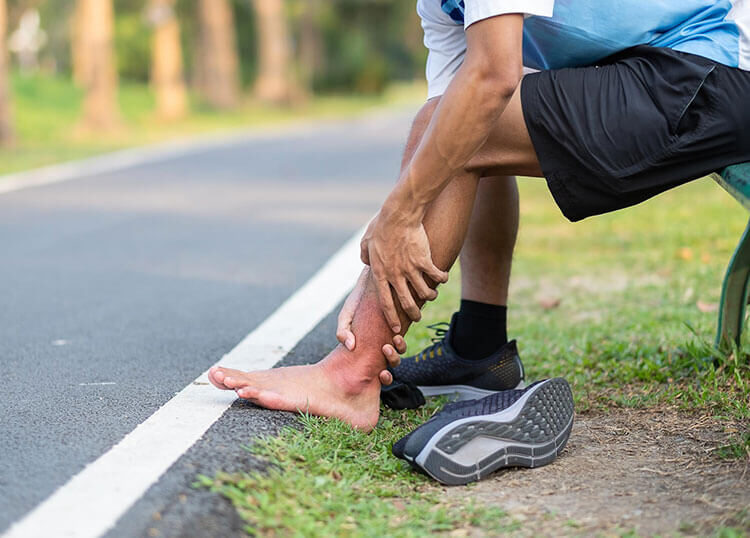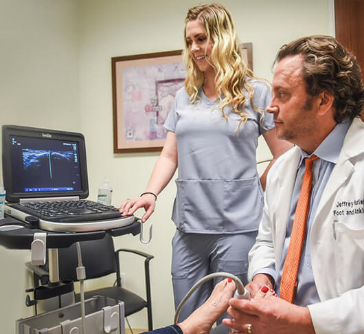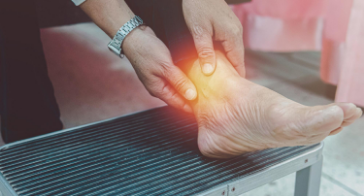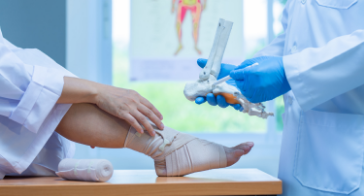
Schedule an Appointment
The Achilles tendon is the largest tendon in the body, connecting the calf muscles to the heel bone and playing a crucial role in mobility. When this tendon experiences a rupture, it can significantly impact daily activities, making it difficult to walk, run, or stand properly. This injury often results from sudden stress or trauma, such as jumping, pivoting, or accelerating quickly.
Achilles tendon rupture treatment varies based on the severity of the tear and the patient’s activity level, ranging from nonsurgical approaches to Achilles tendon rupture surgery for more severe cases.
Symptoms of Achilles Tendon Rupture
Early recognition of an Achilles tendon injury is key to effective treatment. Common symptoms include:
- A sudden, sharp pain in the back of the ankle or calf, is often described as a "pop" or the sensation of being struck.
- Swelling or bruising around the heel and lower leg.
- Difficulty walking, standing on tiptoes, or pushing off the injured foot.
- A visible gap or indentation in the tendon above the heel.
If you suspect an Achilles tendon rupture, seeking immediate medical attention is essential to prevent further complications..
Achilles Tendon Rupture Treatment Options
Treatment for an Achilles tendon injury depends on factors like age, activity level, and the severity of the rupture. Our specialists at Urgent Care for Feet offer both nonsurgical and surgical treatment options.
Nonsurgical Treatment
For mild to moderate ruptures, a nonsurgical approach may be recommended:
- Immobilization: The foot and ankle are placed in a cast, walking boot, or brace to allow the tendon to heal naturally.
- Physical therapy: A structured rehabilitation program helps restore strength, flexibility, and mobility.
Surgical Treatment
Achilles tendon rupture surgery is often preferred for active individuals or patients with severe tears. The procedure involves:
- Reconnecting the torn tendon with sutures.
- A structured post-surgical rehabilitation program to restore function and reduce the risk of re-injury.
Early diagnosis and personalized treatment plans ensure the best recovery outcomes and help prevent long-term complications, such as chronic weakness or re-rupture.
Urgent Care for Achilles Tendon Rupture
At Urgent Care for Feet, we provide immediate evaluation and management of Achilles tendon ruptures. Our team offers:
- Pain relief and injury stabilization
- Diagnostic imaging for accurate assessment
- Immediate immobilization to prevent further damage
- Specialist referrals for advanced surgical treatment, if needed
Seeking prompt treatment can significantly affect healing time and overall recovery.
Get the Care You Need Today
If you've experienced an Achilles tendon rupture, don’t delay treatment. Whether you require conservative care or surgical repair, our expert team is here to provide personalized treatment tailored to your needs.
Contact us today to schedule an appointment and get back on your feet with confidence!

Meet The Specialist
We practice a minimally invasive approach to your foot or ankle problem with surgery as the last option.
Choose a Location Nearest You
Why Urgent Care for Feet

We can treat 90% of cases seen in an emergency room for a fraction of the cost.

All of our doctors have on average 15+ year of experience specializing in foot and ankle care.

We provide on site x-ray that is designed specifically for foot and ankle. This will avoid re-taking an x-ray done improperly at an ER or standard Urgent Care.
Frequently Asked Questions
An Achilles tendon rupture is a tear in the tendon connecting the calf muscles to the heel bone. It is often caused by sudden stress or trauma.
It is typically caused by sudden, forceful movements like jumping, pivoting, or accelerating. Degenerative changes in the tendon can also increase the risk.
Symptoms include a sudden, sharp pain in the back of the ankle, a “popping” sensation, difficulty walking or standing on tiptoes, swelling, and a visible gap in the tendon.
Athletes, individuals aged 30-50, and those engaging in high-impact activities or sports are at higher risk. Other risk factors include obesity, certain medications, and pre-existing tendon issues.
Diagnosis involves a physical exam, where a doctor checks for gaps in the tendon and performs the Thompson test. Imaging, such as ultrasound or MRI, may confirm the rupture.
Treatment options include nonsurgical options like immobilization and physical therapy, as well as surgical repair to reconnect the torn tendon. The choice depends on the severity of the injury and the patient’s activity level.
Surgical treatment involves stitching the torn ends of the tendon, leading to lower re-rupture rates. Nonsurgical treatment relies on immobilization and natural healing but may have a higher risk of re-rupture.
Recovery typically takes 6-12 months, depending on the treatment method and adherence to rehabilitation protocols.
Yes, most patients can return to sports with proper rehabilitation, though it may take several months to regain full strength and function.
Untreated ruptures can lead to chronic weakness, difficulty walking, and long-term pain or disability.
Surgical risks include infection, nerve damage, blood clots, and delayed wound healing.
Partial ruptures may heal with nonsurgical treatment, but complete ruptures generally require medical intervention for optimal recovery.
High-impact sports, such as basketball, soccer, and tennis, and activities involving sudden stops or changes in direction are common causes.
Prevention strategies include proper stretching, strengthening exercises, wearing supportive footwear, and gradually increasing activity levels.
Yes, older individuals may experience slower healing and require longer rehabilitation due to decreased tissue elasticity and healing capacity.
Reviews
This place was the best. Last night I stubbed my toe in the middle of the night and I wasn’t sure if it was broken. I couldn’t even walk. I called and they got me in right away. They took x-rays and put me in a boot because my toe was broken. The office was great and they special in feet yay!
![]()
Caitlyn Meyer
I stepped on a piece of glass and thought I had removed it but every time I stepped down I could feel it. I called Urgent Care For Feet and was seen same day and the doctor removed the glass and the whole staff was great.
![]()


